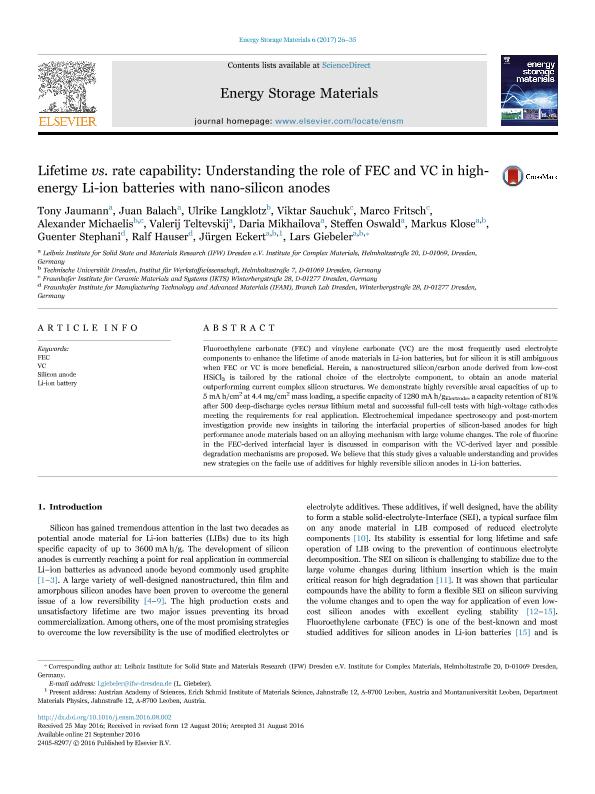Mostrar el registro sencillo del ítem
dc.contributor.author
Jaumann, Tony
dc.contributor.author
Balach, Juan Manuel

dc.contributor.author
Langklotz, Ulrike
dc.contributor.author
Sauchuk, Viktar
dc.contributor.author
Fritsch, Marco
dc.contributor.author
Michaelis, Alexander
dc.contributor.author
Teltevskij, Valerij
dc.contributor.author
Mikhailova, Daria
dc.contributor.author
Oswald, Steffen
dc.contributor.author
Klose, Markus
dc.contributor.author
Stephani, Guenter
dc.contributor.author
Hauser, Ralf
dc.contributor.author
Eckert, Jürgen
dc.contributor.author
Giebeler, Lars
dc.date.available
2020-02-13T20:07:40Z
dc.date.issued
2017-01
dc.identifier.citation
Jaumann, Tony; Balach, Juan Manuel; Langklotz, Ulrike; Sauchuk, Viktar; Fritsch, Marco; et al.; Lifetime vs. rate capability: Understanding the role of FEC and VC in high-energy Li-ion batteries with nano-silicon anodes; Elsevier; Energy Storage Materials; 6; 1-2017; 26-35
dc.identifier.issn
2405-8297
dc.identifier.uri
http://hdl.handle.net/11336/97473
dc.description.abstract
Fluoroethylene carbonate (FEC) and vinylene carbonate (VC) are the most frequently used electrolyte components to enhance the lifetime of anode materials in Li-ion batteries, but for silicon it is still ambiguous when FEC or VC is more beneficial. Herein, a nanostructured silicon/carbon anode derived from low-cost HSiCl3 is tailored by the rational choice of the electrolyte component, to obtain an anode material outperforming current complex silicon structures. We demonstrate highly reversible areal capacities of up to 5 mA h/cm2 at 4.4 mg/cm2 mass loading, a specific capacity of 1280 mA h/gElectrode, a capacity retention of 81% after 500 deep-discharge cycles versus lithium metal and successful full-cell tests with high-voltage cathodes meeting the requirements for real application. Electrochemical impedance spectroscopy and post-mortem investigation provide new insights in tailoring the interfacial properties of silicon-based anodes for high performance anode materials based on an alloying mechanism with large volume changes. The role of fluorine in the FEC-derived interfacial layer is discussed in comparison with the VC-derived layer and possible degradation mechanisms are proposed. We believe that this study gives a valuable understanding and provides new strategies on the facile use of additives for highly reversible silicon anodes in Li-ion batteries.
dc.format
application/pdf
dc.language.iso
eng
dc.publisher
Elsevier

dc.rights
info:eu-repo/semantics/openAccess
dc.rights.uri
https://creativecommons.org/licenses/by-nc-nd/2.5/ar/
dc.subject
FEC
dc.subject
LI-ION BATTERY
dc.subject
SILICON ANODE
dc.subject
VC
dc.subject.classification
Físico-Química, Ciencia de los Polímeros, Electroquímica

dc.subject.classification
Ciencias Químicas

dc.subject.classification
CIENCIAS NATURALES Y EXACTAS

dc.title
Lifetime vs. rate capability: Understanding the role of FEC and VC in high-energy Li-ion batteries with nano-silicon anodes
dc.type
info:eu-repo/semantics/article
dc.type
info:ar-repo/semantics/artículo
dc.type
info:eu-repo/semantics/publishedVersion
dc.date.updated
2020-02-12T17:46:47Z
dc.journal.volume
6
dc.journal.pagination
26-35
dc.journal.pais
Países Bajos

dc.journal.ciudad
Amsterdam
dc.description.fil
Fil: Jaumann, Tony. Ifw Dresden; Alemania
dc.description.fil
Fil: Balach, Juan Manuel. Ifw Dresden; Alemania
dc.description.fil
Fil: Langklotz, Ulrike. Technische Universität Dresden; Alemania
dc.description.fil
Fil: Sauchuk, Viktar. Fraunhofer Institute for Ceramic Materials and Systems; Alemania
dc.description.fil
Fil: Fritsch, Marco. Fraunhofer Institute for Ceramic Materials and Systems; Alemania
dc.description.fil
Fil: Michaelis, Alexander. Technische Universität Dresden; Alemania
dc.description.fil
Fil: Teltevskij, Valerij. Leibniz Institute for Solid State and Materials Research; Alemania
dc.description.fil
Fil: Mikhailova, Daria. Leibniz Institute for Solid State and Materials Research; Alemania
dc.description.fil
Fil: Oswald, Steffen. Leibniz Institute for Solid State and Materials Research; Alemania
dc.description.fil
Fil: Klose, Markus. Leibniz Institute for Solid State and Materials Research; Alemania. Technische Universität Dresden; Alemania
dc.description.fil
Fil: Stephani, Guenter. Branch Lab Dresden. Fraunhofer Institute for Manufacturing Technology and Advanced Materials; Argentina
dc.description.fil
Fil: Hauser, Ralf. Branch Lab Dresden. Fraunhofer Institute for Manufacturing Technology and Advanced Materials; Argentina
dc.description.fil
Fil: Eckert, Jürgen. Technische Universität Dresden; Alemania. Leibniz Institute for Solid State and Materials Research; Alemania
dc.description.fil
Fil: Giebeler, Lars. Leibniz Institute for Solid State and Materials Research; Alemania. Technische Universität Dresden; Alemania
dc.journal.title
Energy Storage Materials
dc.relation.alternativeid
info:eu-repo/semantics/altIdentifier/url/https://www.sciencedirect.com/science/article/pii/S2405829716301404
dc.relation.alternativeid
info:eu-repo/semantics/altIdentifier/doi/https://doi.org/10.1016/j.ensm.2016.08.002
Archivos asociados
